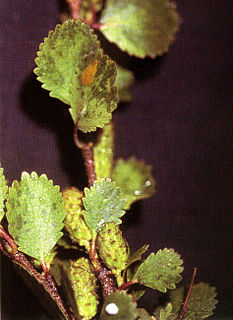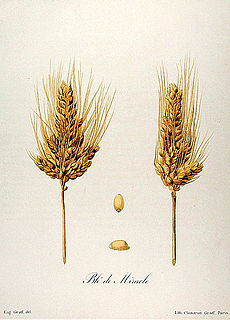Related Research Articles

A birch is a thin-leaved deciduous hardwood tree of the genus Betula, in the family Betulaceae, which also includes alders, hazels, and hornbeams. It is closely related to the beech-oak family Fagaceae. The genus Betula contains 30 to 60 known taxa of which 11 are on the IUCN 2011 Red List of Threatened Species. They are a typically rather short-lived pioneer species widespread in the Northern Hemisphere, particularly in northern areas of temperate climates and in boreal climates.

Betula pendula, commonly known as silver birch, warty birch, European white birch, or East Asian white birch, is a species of tree in the family Betulaceae, native to Europe and parts of Asia, though in southern Europe, it is only found at higher altitudes. Its range extends into Siberia, China, and southwest Asia in the mountains of northern Turkey, the Caucasus, and northern Iran. It has been introduced into North America, where it is known as the European white birch or weeping birch and is considered invasive in some states in the United States and parts of Canada. The tree can also be found in more temperate regions of Australia.

Betula pubescens, commonly known as downy birch and also as moor birch, white birch, European white birch or hairy birch, is a species of deciduous tree, native and abundant throughout northern Europe and northern Asia, growing farther north than any other broadleaf tree. It is closely related to, and often confused with, the silver birch, but grows in wetter places with heavier soils and poorer drainage; smaller trees can also be confused with the dwarf birch.

Betula nigra, the black birch, river birch or water birch, is a species of birch native to the Eastern United States from New Hampshire west to southern Minnesota, and south to northern Florida and west to Texas. It is one of the few heat-tolerant birches in a family of mostly cold-weather trees which do not thrive in USDA Zone 6 and up. B. nigra commonly occurs in floodplains and swamps.

Betula papyrifera is a short-lived species of birch native to northern North America. Paper birch is named for the tree's thin white bark, which often peels in paper like layers from the trunk. Paper birch is often one of the first species to colonize a burned area within the northern latitudes, and is an important species for moose browsing. The wood is often used for pulpwood and firewood.

Betula alleghaniensis, the yellow birch, golden birch, or swamp birch, is a large and important lumber species of birch native to northeastern North America. Its vernacular names refer to the golden color of the tree's bark. The name Betula lutea was used expansively for this tree but has now been replaced.

Betula lenta is a species of birch native to eastern North America, from southern Maine west to southernmost Ontario, and south in the Appalachian Mountains to northern Georgia.

Dactylis is a genus of Eurasian and North African plants in the bluegrass subfamily within the grass family. Dactylis is native to North Africa, they are found throughout the world, and are an invasive species. They are known in English as cock's-foot or cocksfoot grasses, also sometimes as orchard grasses.

Betula nana, the dwarf birch, is a species of birch in the family Betulaceae, found mainly in the tundra of the Arctic region.

Betula neoalaskana or Alaska birch, also known as Alaska paper birch or resin birch, is a species of birch native to Alaska and northern Canada. Its range covers most of interior Alaska, and extends from the southern Brooks Range to the Chugach Range in Alaska, including the Turnagain Arm and northern half of the Kenai Peninsula, eastward from Norton Sound through the Yukon, Northwest Territories, British Columbia, Alberta, Saskatchewan, Manitoba, southern Nunavut, and into northwestern Ontario.

During 10,000 years of cultivation, numerous forms of wheat, many of them hybrids, have developed under a combination of artificial and natural selection. This diversity has led to much confusion in the naming of wheats. This article explains how genetic and morphological characteristics of wheat influence its classification, and gives the most common botanical names of wheat in current use. Information on the cultivation and uses of wheat is at the main wheat page.

Betula populifolia is a deciduous tree native to eastern North America.

Betula occidentalis, the water birch or red birch, is a species of birch native to western North America, in Canada from Yukon east to Northwestern Ontario and southwards, and in the United States from eastern Washington east to western North Dakota, and south to eastern California, northern Arizona and northern New Mexico, and southwestern Alaska. It typically occurs along streams in mountainous regions.

Betula cordifolia, the mountain paper birch is a birch species native to Eastern Canada and the Northeastern United States. Until recently it was considered a variety of Betula papyrifera, with which it shares many characteristics, and it was classified as B. papyrifera var. cordifolia (Regel) Fern.

Betula szechuanica, the Sichuan birch or Szechuan birch, is a birch species native to Sichuan, China, conical in shape, growing to 20 meters in height, with white bark, yellow-green male catkins or green female catkins, and dark, blue-green leaves.

Betula albosinensis, the Chinese red birch, syn. B. bhojpattra var. sinensis, B. utilis var. sinensis, is a species of birch in the family Betulaceae, native to Western China. It is a deciduous tree growing to 25 metres (82 ft). A particular feature is the peeling brown bark. In fact the Latin specific name albosinensis means "white, from China". Brown catkins are produced in Spring.

Betula alnoides is a species of birch that can be found in natural condition of such countries as Bangladesh, Bhutan, Cambodia, China, India, Laos, Myanmar, Nepal, Thailand and Vietnam at an elevation of 300–2,100 metres (980–6,890 ft) and higher in some cases. The southernmost of all known birch species, whose natural range reaches approximately 12° N in Cardamom Mountains, Cambodia.

Taphrina betulina is a fungal plant pathogen that causes the gall, witches broom, which is a chemical infection of birch buds or the developing shoots, leading to a proliferation of growth. It was first described by Emil Rostrup in 1883 and is found in Europe, New Zealand and North America.
References
- ↑ English Names for Korean Native Plants (PDF). Pocheon: Korea National Arboretum. 2015. p. 373. ISBN 978-89-97450-98-5. Archived from the original (PDF) on 25 May 2017. Retrieved 16 December 2016– via Korea Forest Service.
- ↑ Wolfe, Jack A. & Wehr, Wesley C. 1987. Middle Eocene Dicotyledonous Plants from Republic, Northeastern Washington. United States Geological Survey Bulletin1597:13
- ↑ Crane P.R. & Stockey R.A. 1987; "Betula leaves and reproductive structures from the Middle Eocene of British Columbia, Canada." Canadian Journal of Botany65(12): 2490-2500.
- Bean, W. J. 1976, 1988. Trees & Shrubs hardy in the British Isles. Eighth edition, revised, vol. 1 (1976) & Supplement (1988); editor D. L. Clarke.
- Hunt, D. 1993. Betula. Proceedings of the IDS Betula Symposium 2-4 October 1992. International Dendrology Society.
- Li, J., Shoup, S. & Chen, Z.; Shoup, Suzanne; Chen, Zhiduan (2007). "Phylogenetic Relationships of Diploid Species of Betula (Betulaceae) Inferred from DNA Sequences of Nuclear Nitrate Reductase". Systematic Botany. 32 (2): 357–365. doi:10.1600/036364407781179699. S2CID 85837009.
- Rushforth, K. D. 1999. Trees of Britain & Europe. Collins. (Useful details on chromosome numbers of many European & Asian birches).
- Skvortsov, A. K. 2002. A new system of the genus Betula. Byulleten Moskovoskogo Obshchestva Ispytatelei Prirody Otdel Biologie 107: 73–76.
- Flora of North America online - Betula.
- Grimshaw, J. 2009, New Trees, Recent introductions to cultivation. Kew Publishing